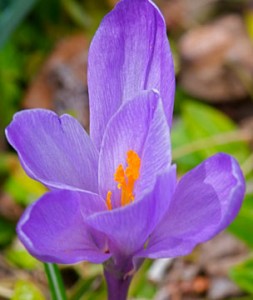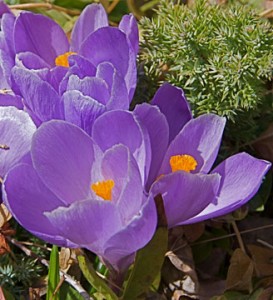Scientific Name: Crocus

Crocus (photo credit: Janice Tucker)
Plant Family: Iridaceae – Iris
Common Name: Saffron
By Janice Tucker
The Crocus species are among the hundreds of plants to be included in the Botanical Garden at Museum Hill. The latest plant collection list is a big step toward the realization of Santa Fe Botanical Garden’s future site, which promises to be an outstanding asset to the community of Santa Fe for both residents and visitors. And, since many species of the Crocus are the first flowers to emerge from the cold and still-frozen ground, it is a good plant to feature at the beginning of the year.
Although the Crocus is native to Europe and West and Central Asia, it has been adapted to climates in many parts of the world. Sources are varied regarding the number of Crocus species, reporting from 80 to 300 species, which includes varieties and cultivars. These plants could be considered the Alpha and Omega of the blooming season since the spring Crocuses are the first plants to bloom, announcing winter’s eventual end and the autumn Crocuses are the last to come into flower after all the other plants have turned out the lights and tucked in for the winter to recharge for the next growing season.
A member of the Iris (Iradaceae) plant family the Crocus is a ground-hugging plant with green, narrow, grass-like leaves and tube-shaped flower buds that sprout directly from the corm. The leaves usually have a white stripe along the middle of the leaf axis, with the margin of the leaf being entire. The unisexual flower is cup-shaped with six slightly layered petals, and usually three stamens (also called snouts) that can appear in colors from yellow to orange to red. Pollination is by insects. The fruit is formed beneath the soil in a triangular-shaped seed capsule. This capsule eventually makes its way to the surface permitting seeds to ripen and germinate, thus allowing the plant to eventually establish a colony (naturalize).
Flower colors cover a large spectrum, but lilac, mauve, yellow and white are predominant. The shape of a Crocus flower has often been mistaken for a low-growing tulip, but the narrow, grass-like leaves will define the difference to the casual observer.
Crocus means saffron, which is the common name. While most gardeners call the flower by its scientific name, the highly valuable snouts (stamen) are what we know as saffron and are collected to be used as a seasoning, dye and for medicinal uses. Saffron seasoning looks like reddish-brown filaments and is quite expensive. It is best used sparingly (too much can cause a bitter flavor). Many gourmet dishes derive a lovely yellow color from saffron, which is used in the preparation of pastries, rice, meats and seafood. It is very important that only professionals collect the stamens since meadow saffron is poisonous and has the same appearance as other saffron stamens. The dried saffron snouts contain essential oils – high in calcium, phosphorus and vitamins. There are many medicinal uses for saffron, including the treatment of stomach, liver and heart diseases as well as a pain reliever, anticonvulsant and cold medicine. It has also been used to clean wounds. The same caution applies: only experts should handle medicinal preparations.

Crocus (photo credit: Janice Tucker)
Growing crocuses in your own garden is easy. They can thrive in half shade/half sun, but produce larger flowers in full sun. Well-drained and well-balanced soils are recommended. Heavier soils may retain too much water, causing the corms to rot. Plant spring crocuses between September and October and autumn crocuses between July and September at a depth approximately two to three times the diameter of the corm, allowing about two inches between plants. Crocuses are cold resistant, but a light covering of mulch during the winter is recommended. Crocuses require little or no supplemental watering, making them ideal for Santa Fe’s dry climate.
The monochromatic winter landscape may be tiring round about January, but be patient. The brilliant colors of the crocus flowers will soon be nosing their way out of the ground to lift the spirits as they announce the promise of spring.


